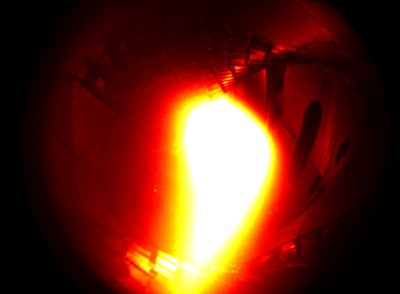
 On the left, inside of the empty stellarator tunnel. On the right, a flash of plasma at 1 million degrees Celsius. (Image credit: Institute for Plasma Physics)
On the left, inside of the empty stellarator tunnel. On the right, a flash of plasma at 1 million degrees Celsius. (Image credit: Institute for Plasma Physics)The Wendelstein 7-X has been in the works for 22 years. After $1 billion and more than 1 million hours of construction, the twisting 53-foot-wide fusion reactor has finally been fired up.
The stellarator itself — which uses 425 metric tons of extremely cold superconducting magnets — was completed in April 2014, and ever since, testing and other preparations have been underway to make sure the machine’s first run went smoothly.
All the work proved time well-spent, as the Thursday power-up went off without a hitch. The W7-X successfully produced plasma from helium gas and reached a temperature of 1 million degrees. The plasma lasted for about one-tenth of a second.
With time, researchers at the Max Planck Institute for Plasma Physics in Germany, which houses the W7-X, will aim to produce longer-lasting plasma with hydrogen and heat it up to 100 million degrees Celsius — the temperature required for fusion to take place.
Stellarators are just one type of nuclear fusion reactor. The most widely used type so far has been the tokamak, which uses an electric current to control the movement of plasma where a stellarator uses a bending, twisting shape.
The benefit of stellarators — and the reason for all of this research — is that they can operate and produce energy continuously, whereas the tokamak can only operate in short bursts.
If the W7-X can achieve its goal and prove stellarators’ utility for power plant usage, it could change the future of clean nuclear energy.
Do you think nuclear fusion is the best option for to meet global energy needs? Comment below or tweet @MNetKatie.






















